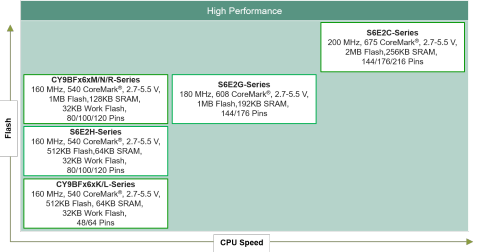FM4 32-bit Arm® Cortex®-M4 Microcontroller (MCU) Families
Best-in-class Arm® - Cortex® M4 Performance for safety-critical, real-time industry system
FM4 32-bit Arm® Cortex®-M4 Microcontroller (MCU) Families 子类别

FM4 microcontrollers operate at frequencies up to 200 MHz and support a diverse set of on-chip peripherals for motor control, factory automation and home appliance applications. The portfolio delivers low-latency, reliable, machine-to-machine (M2M) communication required for Industry 4.0 - the fourth industrial revolution, using network-computing technologies to advance design and manufacturing.
The FM4 portfolio operates at clock frequencies of up to 200 MHz, and supports an operating voltage range of 2.7V to 5.5V. The devices incorporate 256 KB to 2 MB flash and up to 256 KB RAM. The fast flash memory combined with a flash accelerator circuit (pre-fetch buffer plus instruction cache) provides zero-wait-state operation up to 200 MHz. A standard DMA and an additional descriptor based DMA (DSTC), each with an independent bus for data transfer, can be used to further offload the CPU.
The internal, trimmed RC oscillators function as an independent clock source for the clock supervisor and watchdog modules. The devices also feature a two-stage programmable Low Voltage Detector (LVD), a CRC hardware module, a Memory Protection Unit (MPU), and programmable emergency stop input for inverter motor control.
The high-speed, embedded flash memory features a true zero-wait-state operation at 72 MHz. A flash accelerator with pre-fetch buffer and 16 KB instruction cache allows zero-wait-state operation at up to 200 MHz. The flash memory has an endurance of 100,000 write/erase cycles with up to 20 years of data retention. Once enabled, the flash security feature blocks any external read access to the flash memory and therefore secures firmware from being accessed. Many devices feature dual-operation flash for safe EEPROM emulation.
The devices operate from 365uA/MHz, 1.5µA in deep RTC mode. The dedicated, low-power chip design includes clock and power gating. Clock gating can be used to reduce active power consumption by not clocking unused peripherals and therefore preventing them from consuming energy while not in use. Power gating is used to achieve very low current consumption in standby modes by internally disconnecting parts of the MCU from the supply voltage. There are multiple low-power options for finely tuned power-saving modes, and a dedicated power domain for deep standby modes.
The devices include support for Ethernet, CAN (controller area network), CAN-FD (CAN with flexible datarate) and USB2.0 (device and host). Motor-control features include up to three multifunction timers and a respective number of quadrature decoder units. The MCUs include up to three high-speed, 12-bit A/D converters, which can be triggered synchronously and have a conversion time of 0.5µs. Other features include HMI input devices, universal base timers, a sub-clock option, and flexible, multi-function serial interfaces supporting UART,SPI,I2C, and LIN.
S6E2Dx Series devices feature a dedicated 2D graphics accelerator subsystem to drive TFT based HMI systems. With 512 kbytes internal VRAM, and optional external SDRAM and HYPERBUS™/Q-SPI interfaces to external flash, the hardware 2D accelerator with Blit engine enables impressive graphics HMIs with a very low BOM cost.



